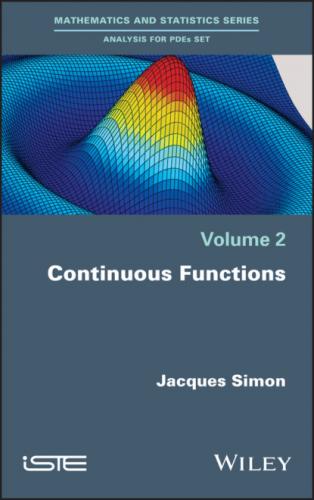257 244
258 245
259 246
260 247
261 248
To Claire and Patricia, By your gaiety, “joie de vivre”, and femininity, you have embellished my life, and you have allowed me to conserve the tenacity needed for this endeavor
Analysis for PDEs Set
coordinated by
Jacques Blum
Volume 2
Continuous Functions
Jacques Simon
First published 2020 in Great Britain and the United States by ISTE Ltd and John Wiley & Sons, Inc.
Apart from any fair dealing for the purposes of research or private study, or criticism or review, as permitted under the Copyright, Designs and Patents Act 1988, this publication may only be reproduced, stored or transmitted, in any form or by any means, with the prior permission in writing of the publishers, or in the case of reprographic reproduction in accordance with the terms and licenses issued by the CLA. Enquiries concerning reproduction outside these terms should be sent to the publishers at the undermentioned address:
ISTE Ltd
27-37 St George’s Road
London SW19 4EU
UK
John Wiley & Sons, Inc.
111 River Street
Hoboken, NJ 07030
USA
© ISTE Ltd 2020
The rights of Jacques Simon to be identified as the author of this work have been asserted by him in accordance with the Copyright, Designs and Patents Act 1988.
Library of Congress Control Number: 2020933955
British Library Cataloguing-in-Publication Data
A CIP record for this book is available from the British Library
ISBN 978-1-78630-010-2
Introduction
Objective. This book is the second of six volumes in a series dedicated to the mathematical tools for solving partial differential equations derived from physics:
Volume 1: Banach, Frechet, Hilbert and Neumann Spaces;
Volume 2: Continuous Functions;
Volume 3: Distributions;
Volume 4: Lebesgue and Sobolev Spaces;
Volume 5: Traces;
Volume 6: Partial Differential Equations.
This second volume is devoted to the partial differentiation of functions and the construction of primitives, which is its inverse mapping, and to their properties, which will be useful for constructing distributions and studying partial differential equations later.
Target audience. We intended to find simple methods that require a minimal level of knowledge to make these tools accessible to the largest audience possible – PhD candidates, advanced students1 and engineers – without losing generality and even generalizing some standard results, which may be of interest to some researchers.
Originality. The construction of primitives, the Cauchy integral and the weighting with which they are obtained are performed for a function taking values in a Neumann space, that is, a space in which every Cauchy sequence converges.
Neumann spaces. The sequential completeness characterizing these spaces is the most general property of E that guarantees that the integral of a continuous function taking values in E will belong to it, see Case where E is not a Neumann space (§ 4.3, p. 92). This property is more general than the more commonly considered property of completeness, that is the convergence of all Cauchy filters; for example, if E is an infinite-dimensional Hilbert space, then E-weak is a Neumann space but is not complete [Vol. 1, Property (4.11), p. 82].
Moreover, sequential completeness is more straightforward than completeness.
Semi-norms. We use families of semi-norms, instead of the equivalent notion of locally convex topologies, to be able to define differentiability (p. 73) by comparing the semi-norms of a variation of the variable to the semi-norms of the variation of the value. A section on Familiarization with Semi-normed Spaces can be found on p. xiii. Semi-norms can be manipulated in a similar fashion to normed spaces, except that we are working with several semi-norms instead of a single norm.
Primitives. We show that any continuous field q = (q1, . . . , qd) on an open set Ω of ℝd has a primitive f, namely that ∇f = q, if and only if it is orthogonal to the divergence-free test fields, that is, if
When Ω is simply connected, for a primitive f to exist, it is necessary and sufficient for q to have local primitives. This is the local primitive gluing theorem (Theorem 9.4). On any such open set, it is also necessary and sufficient that it verifies Poincaré’s condition ∂iqi = ∂jqi for every i and j to be satisfied if the field is C1 (Theorem 9.10), or a weak version of this condition,
We explicitly determine all primitives (Theorem 9.17) and construct one that depends continuously on q (Theorem 9.18).
Integration. We extend the Cauchy integral to uniformly continuous functions taking values in a Neumann space, because this will be an essential tool for constructing primitives.
The properties established here for continuous functions will also be used to extend them to integrable distributions in Volume 4, by continuity or transposition. Indeed, one of the objectives of the Analysis for PDEs series is to extend integration and Sobolev spaces to take values in Neumann spaces. However, it seemed more straightforward to first construct distributions (in Volume 3) using just continuous functions before introducing integrable distributions (in Volume 4), which play the role usually fulfilled by classes of almost everywhere equal integrable functions.
Weighting. The weighted function
